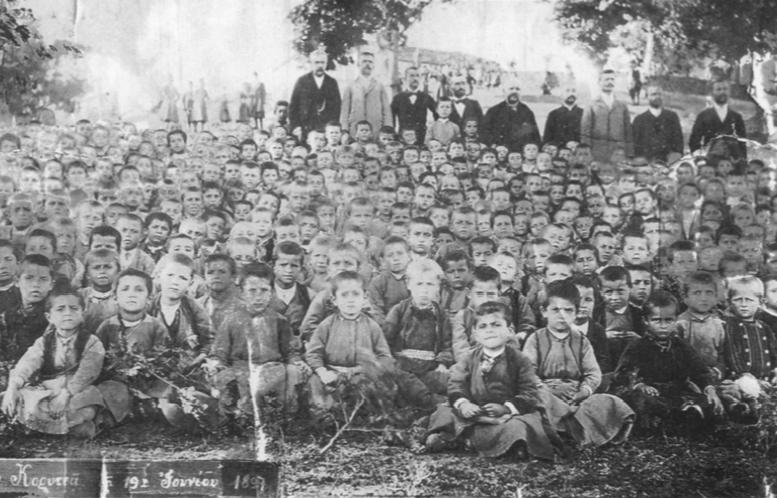Lasso fund on:
[Wikipedia]
[Google]
[Amazon]
 Lasso Fund ( el, Ταμείο Λάσσον) was a community fund established in the town of
Lasso Fund ( el, Ταμείο Λάσσον) was a community fund established in the town of
 In 1850 the Orthodox bishop of Korçë, Neophytus, decided to create a special community fund in order to safeguard the various donations and bequests from the Orthodox diaspora of the city and to ensure that they would be properly disposed for educational and cultural purposes.
This fund, was known under the name ''Lasso fund''. According to article 2 of the fund's statute the primary objective of Lasso fund was:
Its harmonious management was presented as a basic duty of the community. In 1875, the "General Regulations of the Common Foundation of the Town Korytsa (Korçë)" were drafted and put into effect the next year. Under these all bequest and donations were taken under the responsibility of the Lasso fund. The general organization of the Lasso was reminiscent to the
In 1850 the Orthodox bishop of Korçë, Neophytus, decided to create a special community fund in order to safeguard the various donations and bequests from the Orthodox diaspora of the city and to ensure that they would be properly disposed for educational and cultural purposes.
This fund, was known under the name ''Lasso fund''. According to article 2 of the fund's statute the primary objective of Lasso fund was:
Its harmonious management was presented as a basic duty of the community. In 1875, the "General Regulations of the Common Foundation of the Town Korytsa (Korçë)" were drafted and put into effect the next year. Under these all bequest and donations were taken under the responsibility of the Lasso fund. The general organization of the Lasso was reminiscent to the
Revista romanǎ de sociologie
p.526 Institute of Sociology of the Academy of Sciences of Romania, 2006
Korçë
Korçë (; sq-definite, Korça) is the eighth most populous city of the Republic of Albania and the seat of Korçë County and Korçë Municipality. The total population is 75,994 (2011 census), in a total area of . It stands on a plateau som ...
in 1850 in order to safeguard donations and bequests of the local Orthodox diaspora. As a result, Greek-language schools for the Orthodox community as well as churches, pharmacies and hostels were opened in Korçë.
Regulations
English trusts law
English trust law concerns the protection of assets, usually when they are held by one party for another's benefit. Trusts
A trust is a legal relationship in which the holder of a right gives it to another person or entity who must keep a ...
of that time.
The capital of the fund was deposited in the National Bank of Greece
The National Bank of Greece (NBG; el, Εθνική Τράπεζα της Ελλάδος) is a global banking and financial services company with its headquarters in Athens, Greece.
85% of the company's pretax preprovision profits are derived ...
in an account titled "Assets of the Educational Institutions of Korytsa" with an annual depreciation rate of 6% on the capital circulating in the form of bonds. According to the special regulations of the Lasso, the local schools were maintained exclusively by its interest, while only a part of the capital was given to solvent citizens in the form of interest-bearing loans.
Significant contributors
This initiative resulted in the increase of cultural activity in Korçë, especially in the foundation of Orthodox schools, as well the erection of other public welfare institutions such as churches, pharmacies and hostels.Ismyrliadou, 1996: p. 241 Among the benefactors that contributed to the Lasso fund was Georgios Pagkas, who supported it with considerable sums. Other significant contributors included the son of the latter, Ioannis Pagkas, in particular with the sponsoring of the Pagkas Gymnasium, and Anastas Avramidhi-Lakçe and Kostaq Duro, heads of the Albanian cultural institution ''Dituria'' in Romania.p.526 Institute of Sociology of the Academy of Sciences of Romania, 2006
References
Sources
*{{cite journal , last = Ismyrliadou , first = Adelais , year = 1996, title = Educational and Economic Activities in the Greek Community of Koritsa during the Second Half of the Nineteenth Century, journal = Balkan Studies , volume = 1 , issue = 37 , pages = 235–255 , url =https://books.google.com/books?id=XVRpAAAAMAAJ&q=%22educational+and+economic+activities+in+the+Greek+community+of+Koritsa%22 Korçë